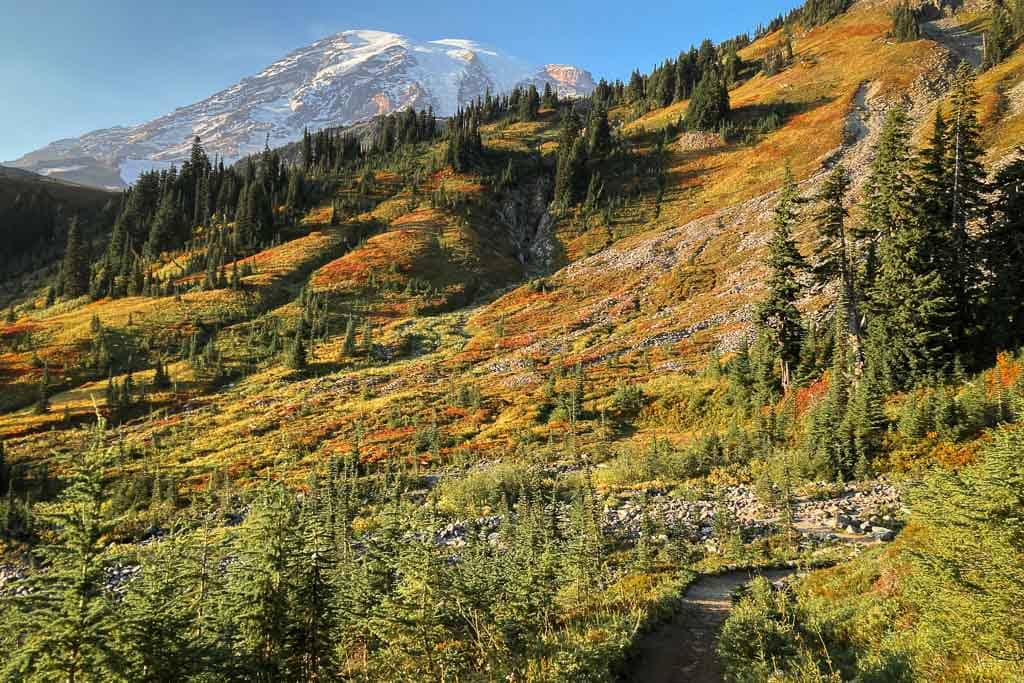9 Fun Fall Activities in Mount Rainier National Park
Articles Topics: Fall Activities in Mount Rainier National Park, Things to Do at Mount Rainier in the Fall
It may not have Shenandoah or Acadia’s big oaks and maples, or the vibrant aspen forests of Rocky Mountain and Grand Teton, but Mount Rainier National Park very much has its own kind of fall colors.
This spectacular national park in central Washington, also famous for its waterfalls and summer wildflowers, is home to meadows full of colorful huckleberry bushes and stands of tamarack, a remarkable deciduous conifer.
What to Do in Mount Rainier National Park in the Fall
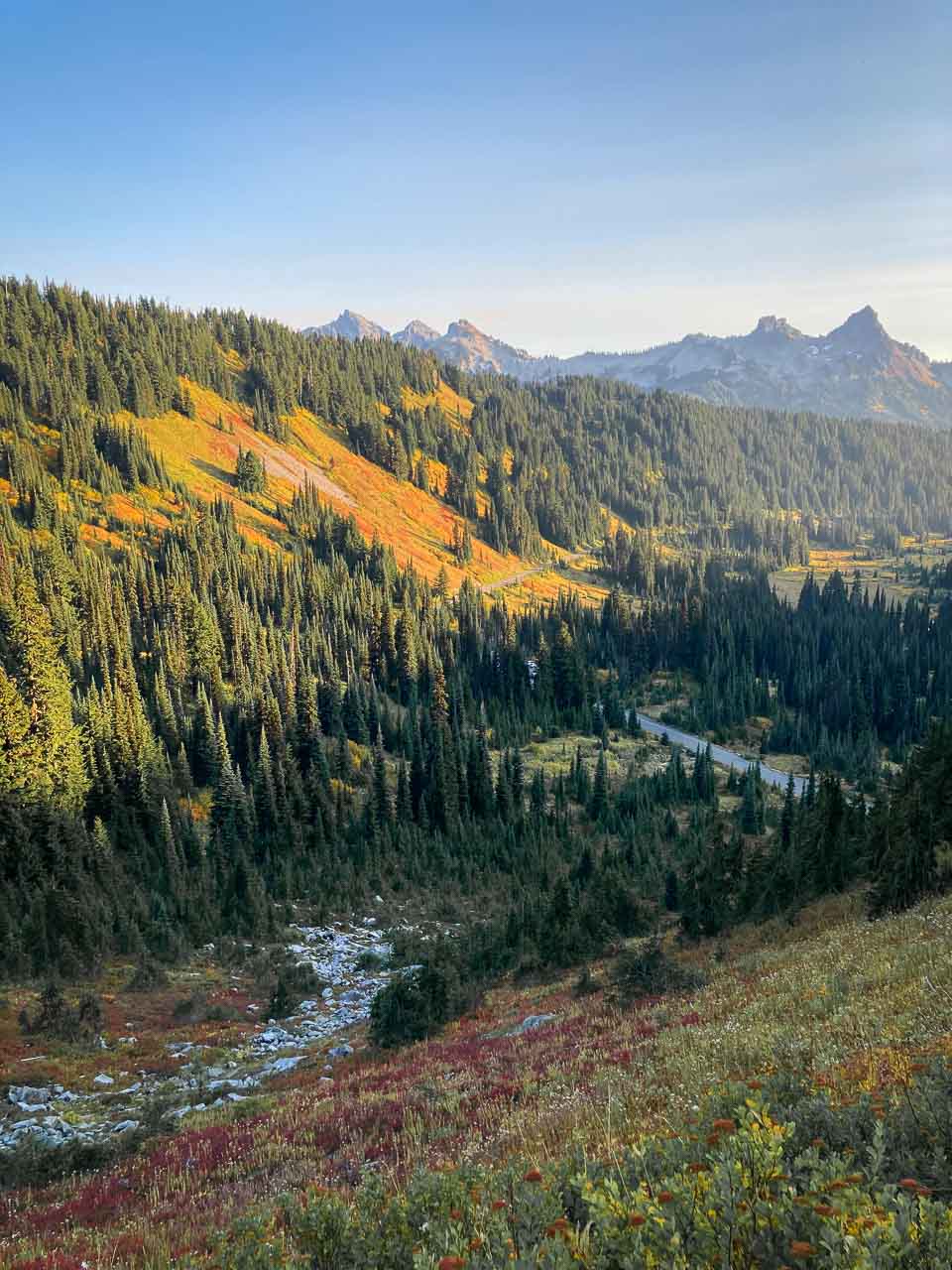
A high-elevation park, much of the fall foliage at Mount Rainier is provided by shrubs, bushes and small trees, such as huckleberry, elderberry, vine maples and cottonwoods.
It’s the huckleberries, though, that steal the show. These low shrubs turn brilliant red in the fall, coloring the park’s meadows and slopes in warm and vibrant hues.
9 Fun Activities to Enjoy Beautiful Mount Rainier National Park Fall Colors
Below, you’ll find several ways to enjoy, indulge and immerse yourself in the beautiful fall colors of Mount Rainier National Park. These are my favorite things to do at Mount Rainier in autumn.
This post about the best things to do in Mount Rainier National Park in fall contains affiliate links. You can read more about our Terms of Use / Disclosure here.
1. Hike Amid Mount Rainier Fall Foliage on the Skyline Trail
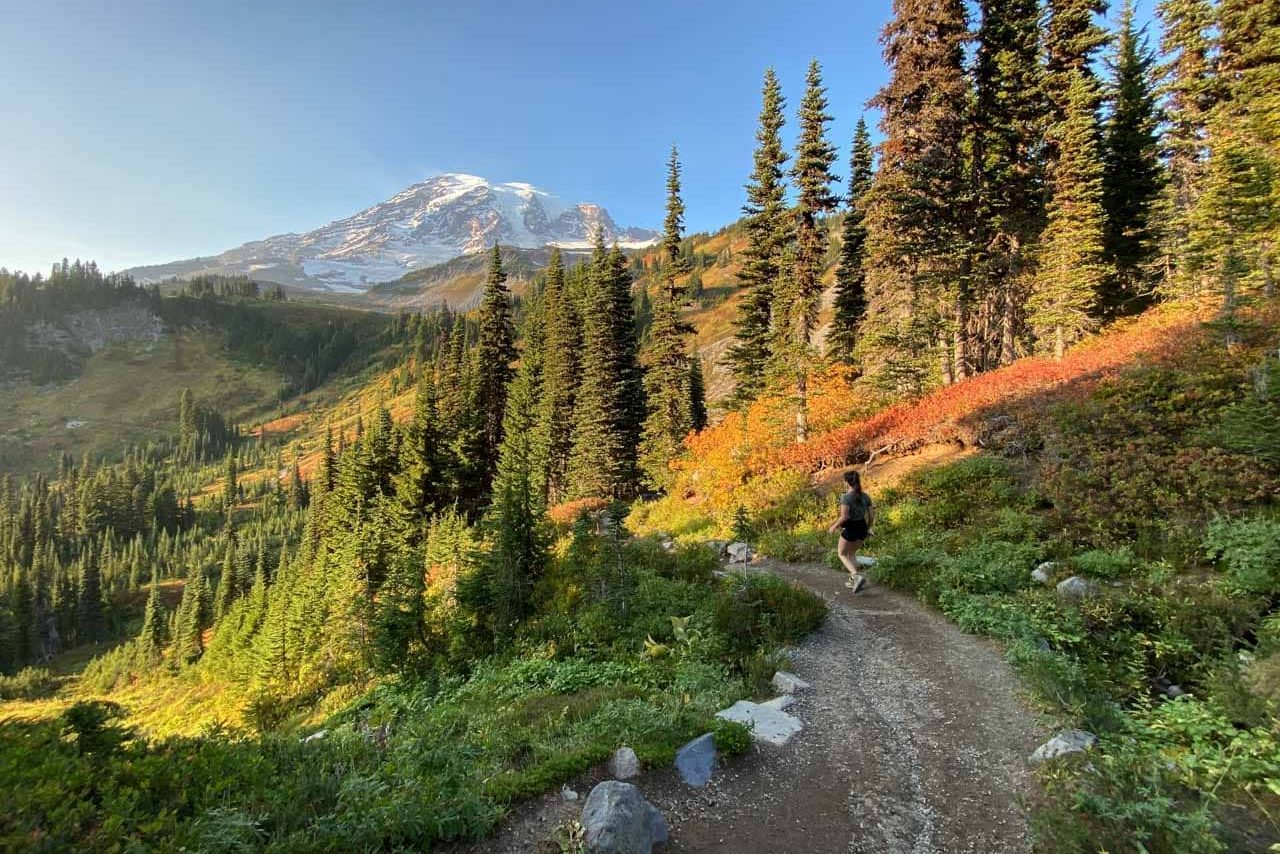
If I had to pick the single best fall activity in Mount Rainier National Park, I wouldn’t hesitate a second. Nothing beats the sensational Skyline Trail—this trail is so awesome we hiked it twice!
The Skyline Trail starts directly behind the Jackson Visitor Center and Paradise Inn at Paradise, where a huge parking lot accommodates the hundreds of visitors that swarm this popular area from summer through fall.
In summer, this is one of the best places to see alpine wildflowers, while in October, the fall colors are absolutely glorious.
After he visited Paradise at Mount Rainier, the legendary conservationist John Muir quite rightly called it:
“…the most luxuriant and the most extravagantly beautiful of all the alpine gardens I ever beheld in all my mountain-top wanderings”
– John Muir, 1889

On this 5.5-mile loop, you’ll walk through brilliant patches of huckleberries, across lush alpine meadows and past panoramic viewpoints.
Highlights include the huge Nisqually Glacier and Panorama Point, which offers a view that includes the Tatoosh Range and other Cascade volcanoes like Mount Adams, Mount St. Helens and Mt. Hood.
Hike the Skyline Trail in a clockwise direction to save the best for last: picturesque Edith Creek and Myrtle Falls with Rainier rising up in the background.
Almost the entire way, you’ll be accompanied by vivid Mount Rainier fall foliage, from vine maple oranges to huckleberry reds.
2. Look for Wildlife in Paradise
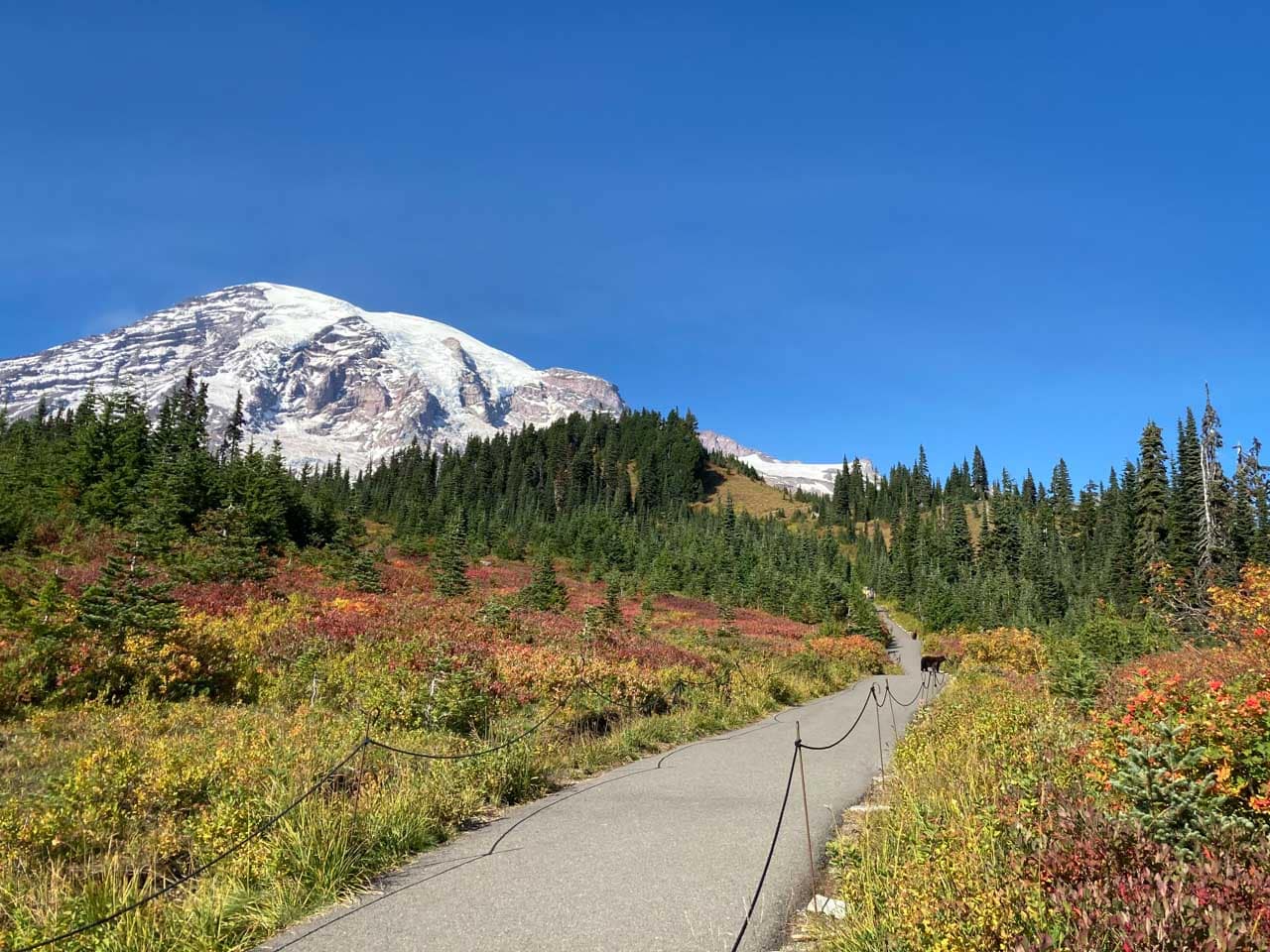
Fall in Mount Rainier is also a great time to see some of the park’s abundant wildlife.
Black-tailed deer are often seen browsing the vegetation of the Paradise meadows, while mountain goats wander across rocky slopes at higher elevations. Hoary marmots and pikas live above the tree line, their presence revealed by their typical whistles and calls.
Arguably the most exciting animal you can regularly see in Paradise and around the Paradise Inn, however, are black bears. Autumn is foliage season for humans and berry-eating season for the bears.
The abundance of huckleberries and elderberries attract numerous black bears to the crowded Paradise area in the fall.
Trying to gain as much as weight as fast as possible before winter arrives, black bears forage in berry patches, forest clearings and meadows. I’ve seen as many as six black bears in a single afternoon in this area in autumn.
Remember, though, that black bears are wild animals and can be dangerous. Stay at least 100 yards away from them. You can learn what to do when encountering a black bear here. When hiking at Mount Rainier, you should carry bear spray, just in case, and know how to use it.
3. Go Berry Picking in Mount Rainier National Park
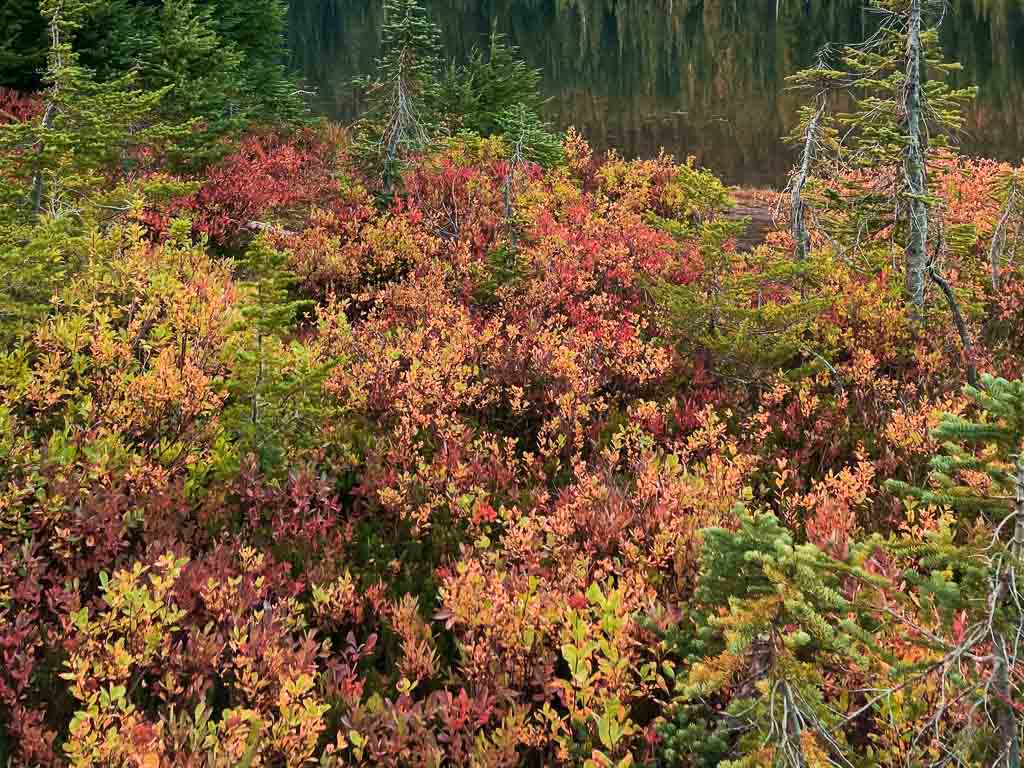
Although commercial berry picking is not allowed in the park, you can actually pick huckleberries, salmonberries, blackberries and thimbleberries for “personal use.”
Berry picking in Mount Rainier National Park is easily one of the best ways to experience fall in the park.
Note, however, that there’s a limit on how many berries you’re allowed to pick: up to 2 quarts per person per day.
If you’re just munching on berries as you’re hiking, there’s no limit, but you probably won’t eat more than two quarts anyway. Remember to stay on the trails, though, to protect the park’s natural resources, including its berries.
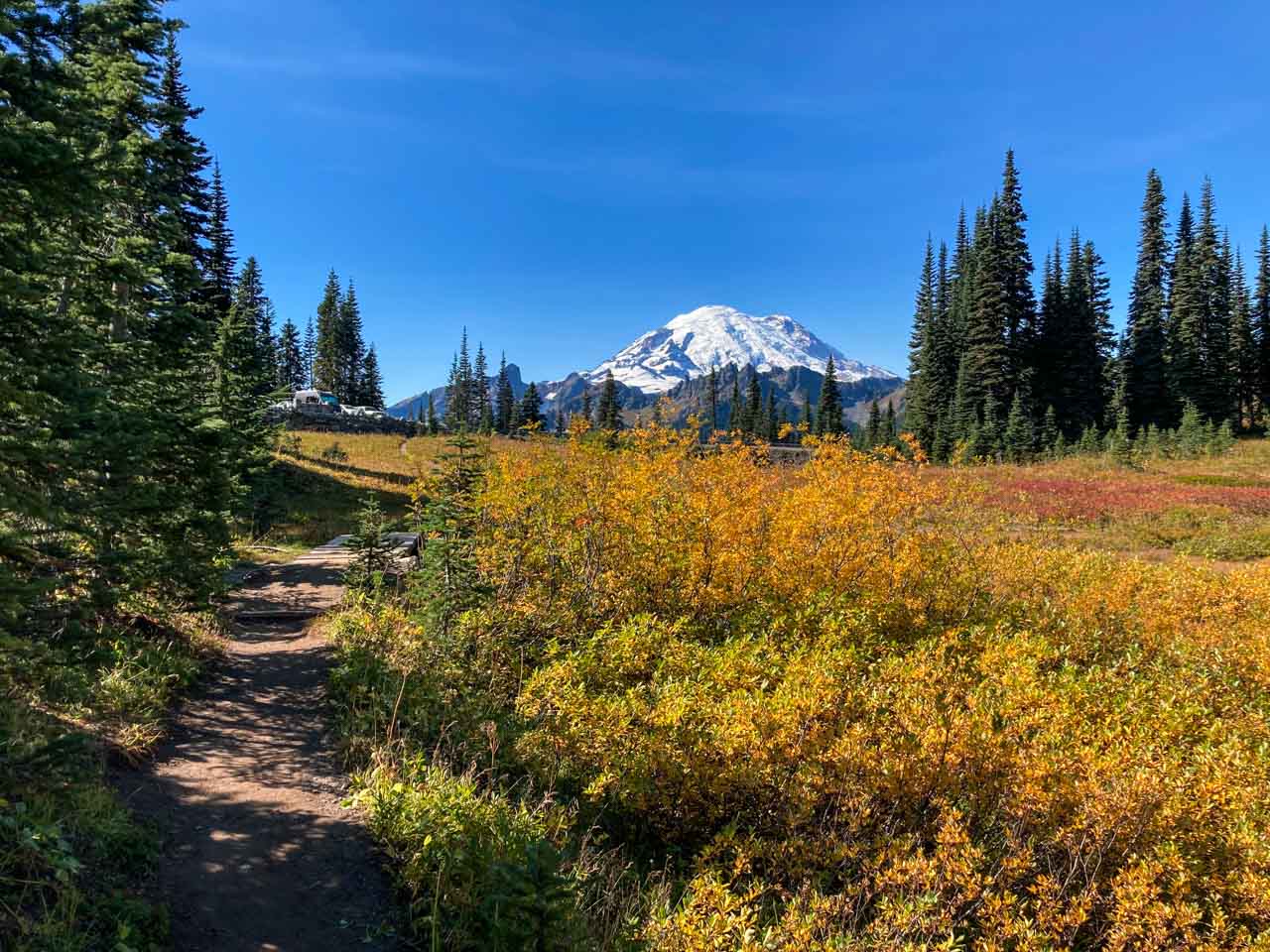
A great hike for berry picking at Mount Rainier in the fall is the Naches Peak Loop, which encircles Tipsoo Lake. Enjoy the scenery and the sweet taste of berries, but watch for black bears in this area. They love these healthy natural treats as well.
Another beautiful area is Indian Henry’s Hunting Ground. This remote mountain meadow reached via a strenuous hike on the Wonderland Trail from Longmire. It’s a challenging 13-mile roundtrip, but oh-so-worth it.
4. Admire the Perfect Mirror Image of Mount Rainier at Reflection Lakes
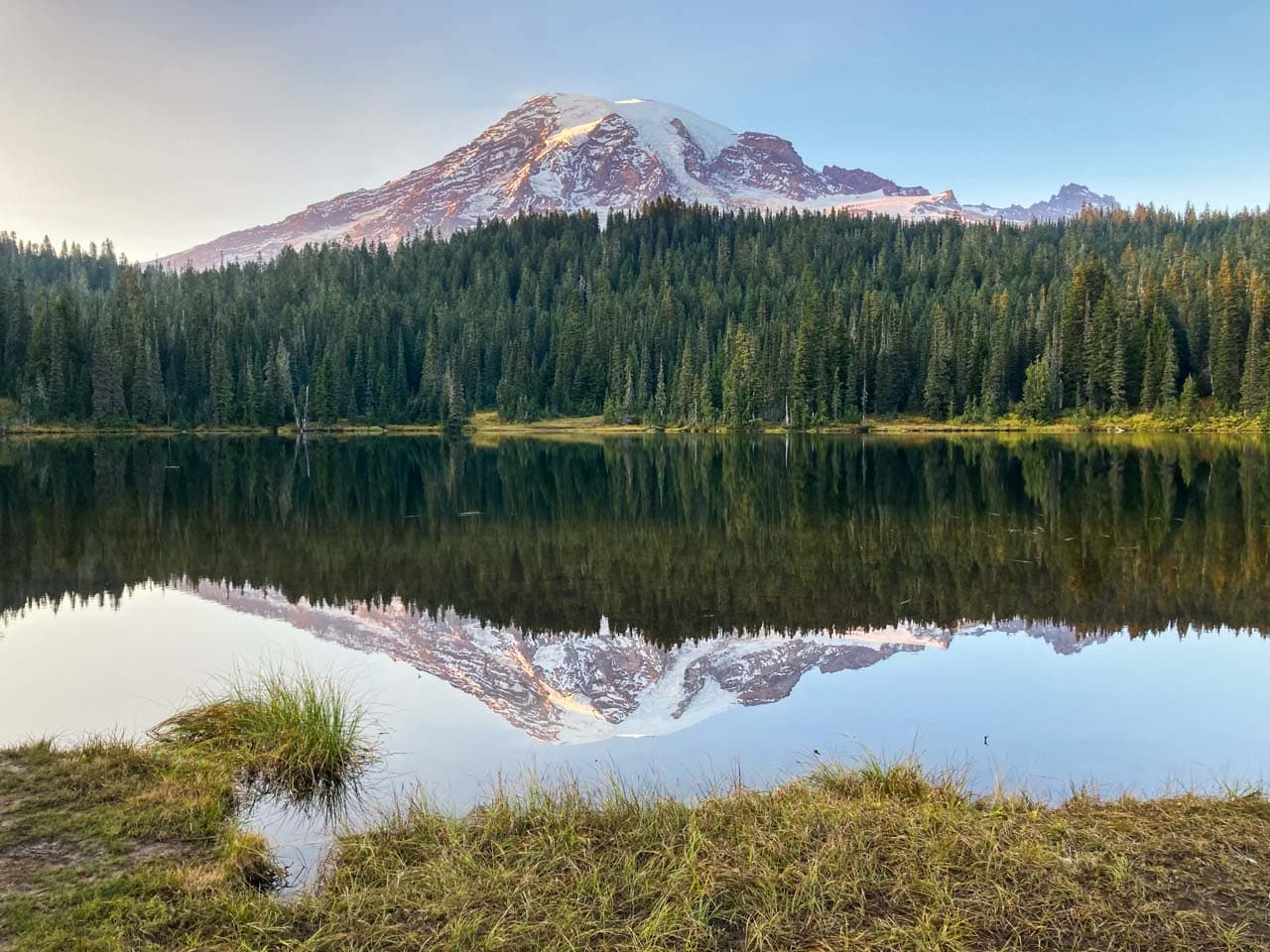
Located below Paradise on the Stevens Canyon Road, the popular Reflection Lakes offer some of the most famous views of Mount Rainier.
The best time to visit this beautiful location is either early in the morning or late in the evening. This is when the lakes’ water usually is at its stillest, thus providing the nicest reflections of the mountain.
On quiet and clear days, this is one of my favorite places to see the sunset in Mount Rainier National Park.
A variety of bushes and shrubs lines the lakeshores, adding some of that gorgeous fall foliage to the landscape.
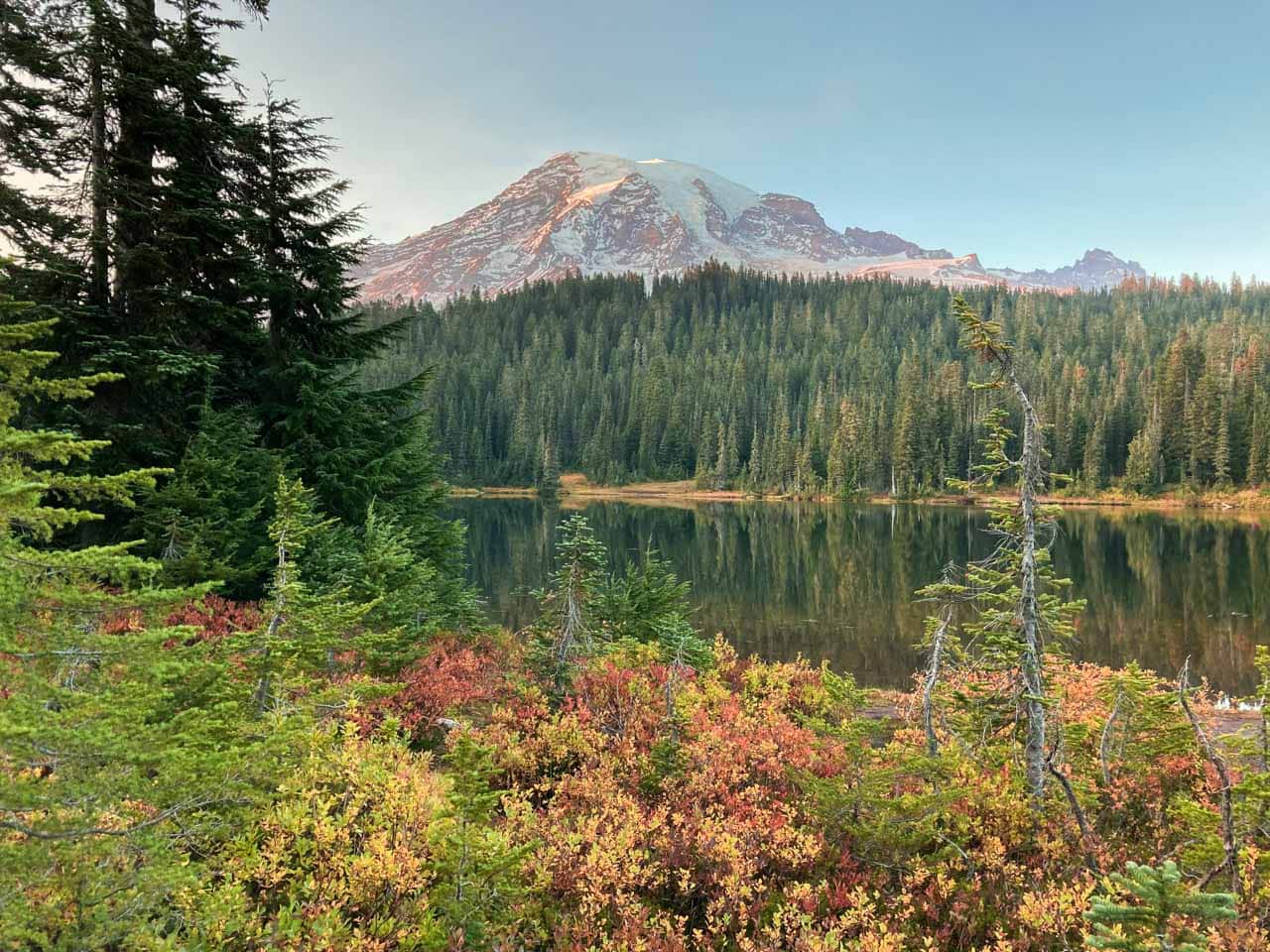
If you’re up for a short hike, consider hiking the Reflection Lakes Loop. This 2.8-mile loop starts at the Reflection Lakes parking area and is best hiked in a clockwise direction.
It’s a combination of the Wonderland Trail, the Lower Lakes Trail and the High Lakes Trail, as well as the Mazama Ridge Trail back down.
5. See Scenic Silver Falls
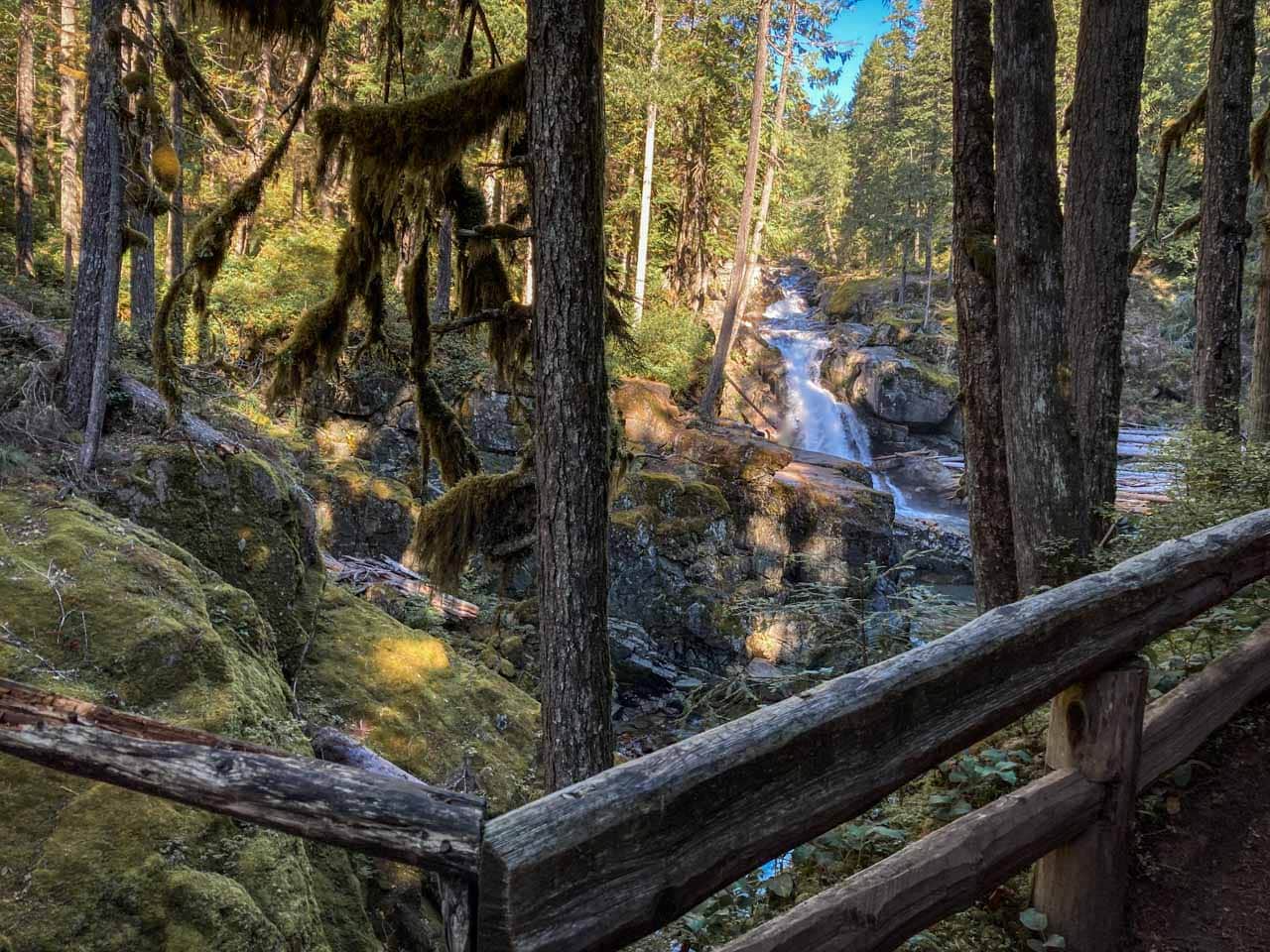
The Silver Falls Trail doesn’t offer as many autumn colors as the other fall activities in Mount Rainier National Park in this list.
It does, however, make for a pleasant stroll underneath the old-growth trees along the Ohanapecosh River. On a crisp October morning, a walk in this fragrant forest is absolutely delightful. And there absolutely are some Mount Rainier fall colors to be found here, too.
On the way, you can experience the bustling of life in Mount Rainier’s pristine forests. Listen for the tapping of woodpeckers and the rustling of deer in the bushes.
Enjoy the sounds of the crystal-clear water of the river as it tumbles down cascades. Inhale a lungful of healthy forest air, smell the earthy scents of bark and leaf.
The highlight of this wonderful fall hike is Silver Falls itself, a large 75-foot waterfall thundering into a gorge, about 1.5 miles from the trailhead at the Ohanapecosh Campground. A scenic bridge crosses the gorge, making for a great photo location. This loop hike is about 3 miles long.
6. Picnic at Picture-Perfect Tipsoo Lake
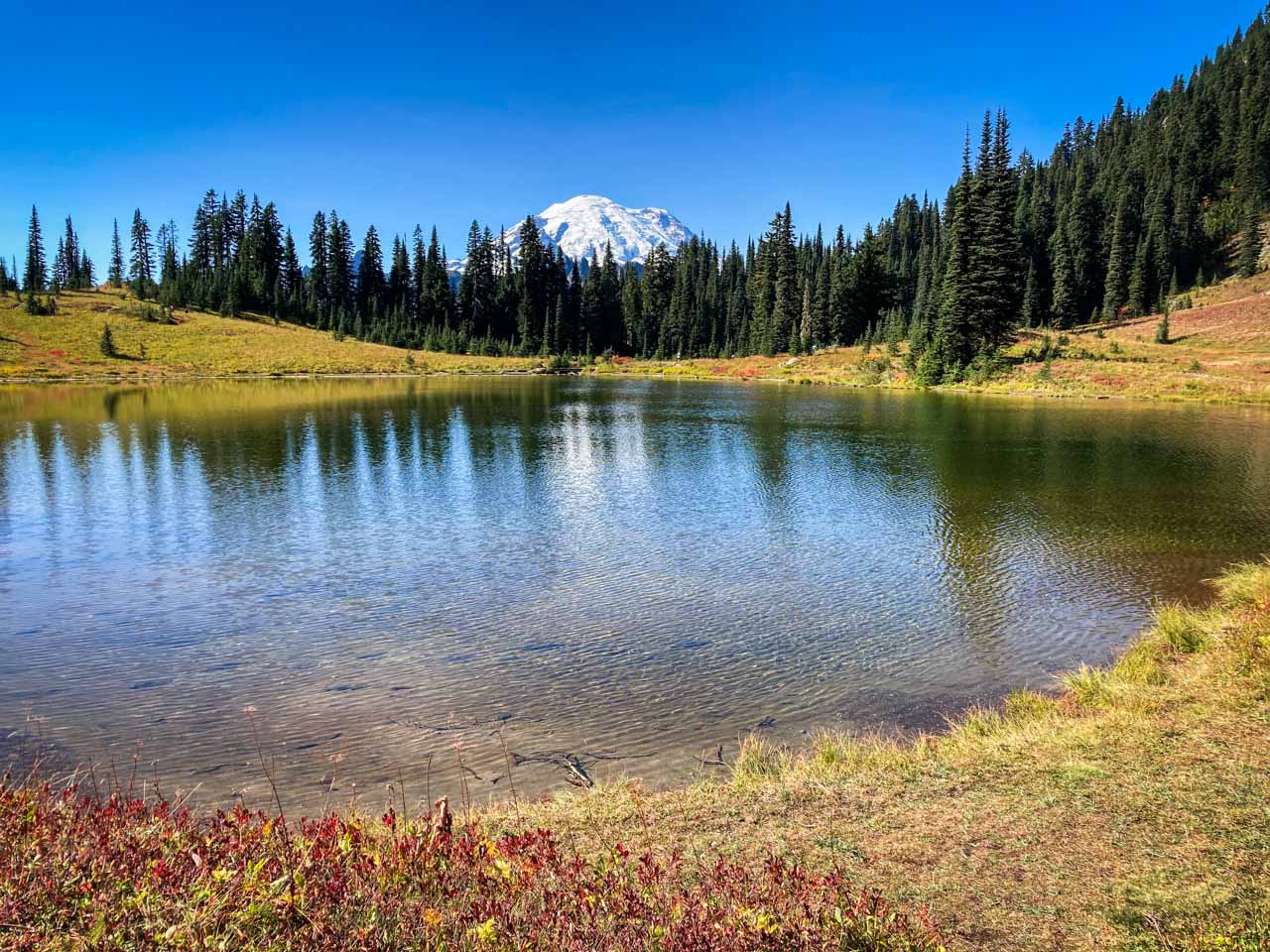
Tipsoo Lake might just be my favorite place for fall foliage in Mount Rainier National Park. This beautiful little lake sits below Chinook Pass in the east of the park, providing visitors with a perfect picnic spot.
There are picnic tables at the spacious parking lot, while a flat and easy trail loops around the lake. Take a stroll in this peaceful area, soaking up the wonderful autumn colors all around you.
Additionally, Tipsoo Lake is also a nice spot for bird watching, while you might also spot deer and even a black bear here at dusk.
7. Enjoy the Iconic Fall Landscape from Chinook Pass
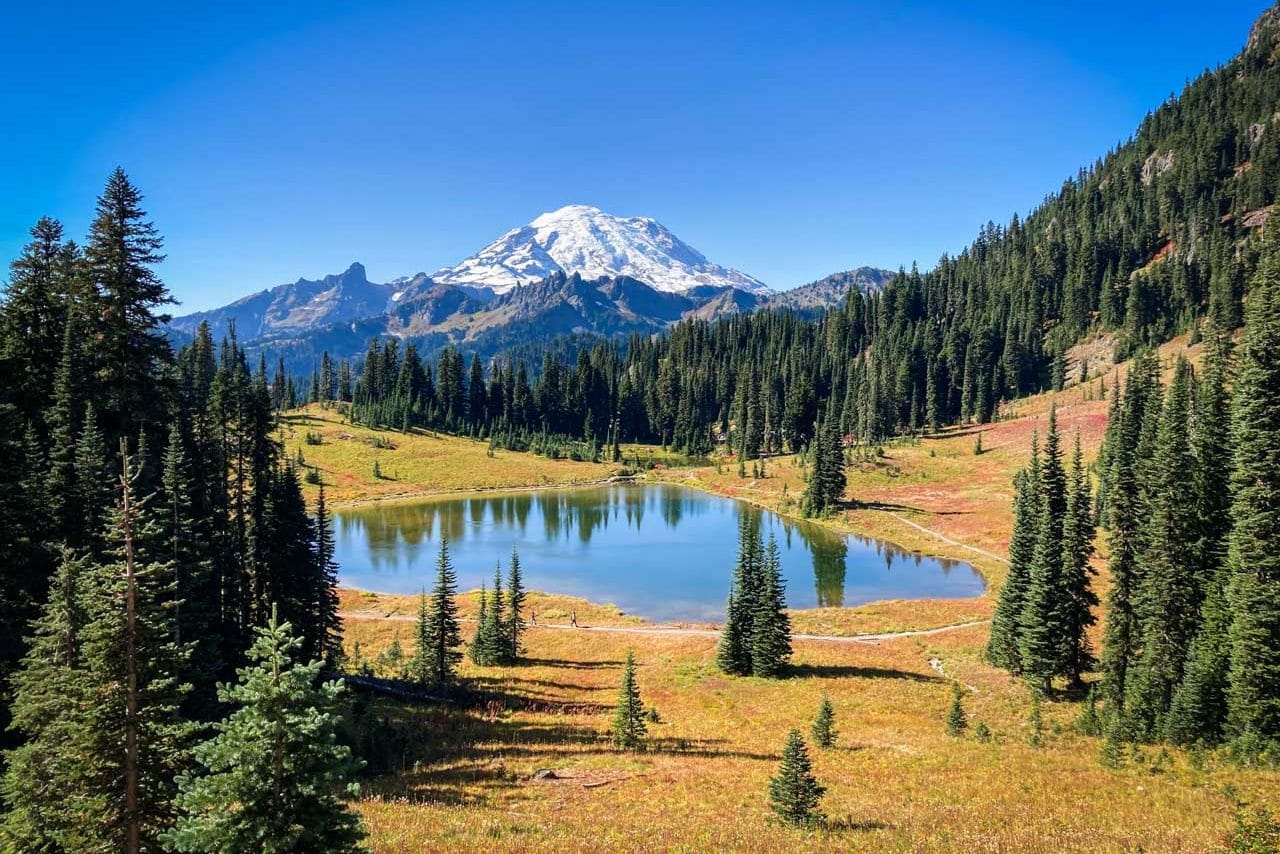
Chinook Pass is essentially the east entrance of Mount Rainier National Park. This high-elevation road, Route 410, enters the park from Wenatchee National Forest to the east, and what an entry it is.
As soon as you enter the park—you can also drive up from the main road in the park’s east side—a spectacular panorama opens up, dominated by massive Mount Rainier itself.
There’s lots of parking space along the road below Chinook Pass. Walk along the edge of the parking lot and take in this iconic view.
Tipsoo Lake shimmers prettily below, while Rainier towers in the background. This is one of the most iconic overlooks in the national parks.
8. Hike to the Summit(s) of Burroughs Mountain

For up-close views of mighty Mount Rainier itself, few trails are better than the Burroughs Mountain Trail. Starting at the Sunrise Visitor Center, this strenuous trail is a great early-fall hike for two reasons.
One, the lower elevations and meadows boast beautiful fall colors, and two, the higher elevations—an Arctic tundra environment—are free of snow this time of year.
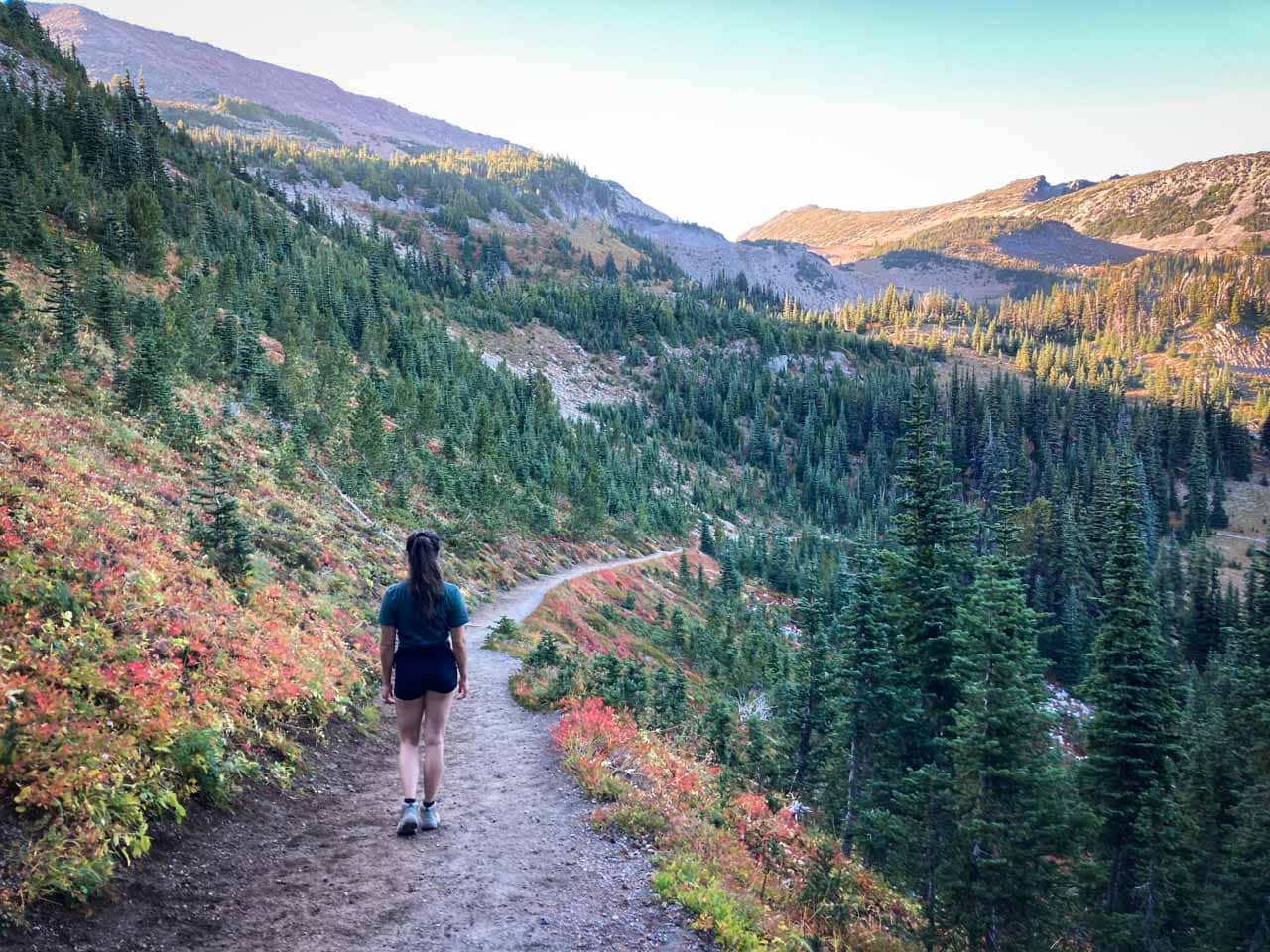
When hiked in a counterclockwise direction, the first part of this amazing hike, one of my all-time favorite Mount Rainier National Park hikes, is along the Sourdough Ridge Trail. Once you arrive at Frozen Lake, follow the Burroughs Mountain Trail to the top of First Burroughs Mountain.
Although the views are pretty amazing there, I encourage you to continue to Second Burroughs Mountain summit, where Rainier is breathtakingly close.
Enjoy spectacular views of the gigantic Emmons Glacier, the largest glacier in the contiguous United States, and the White River.
Watch for mountain goats, which are quite common here. We saw a large group of them on a slope in the distance. (These are the binoculars I use.)
Make this a 6-mile loop hike by taking the Sunrise Rim Trail back to the parking lot at Sunrise. On the way back, Mount Rainier will accompany you on your right side, while beautiful meadows display vibrant fall colors all around.
9. Spend the Night at Mount Rainier’s Historic Paradise Inn
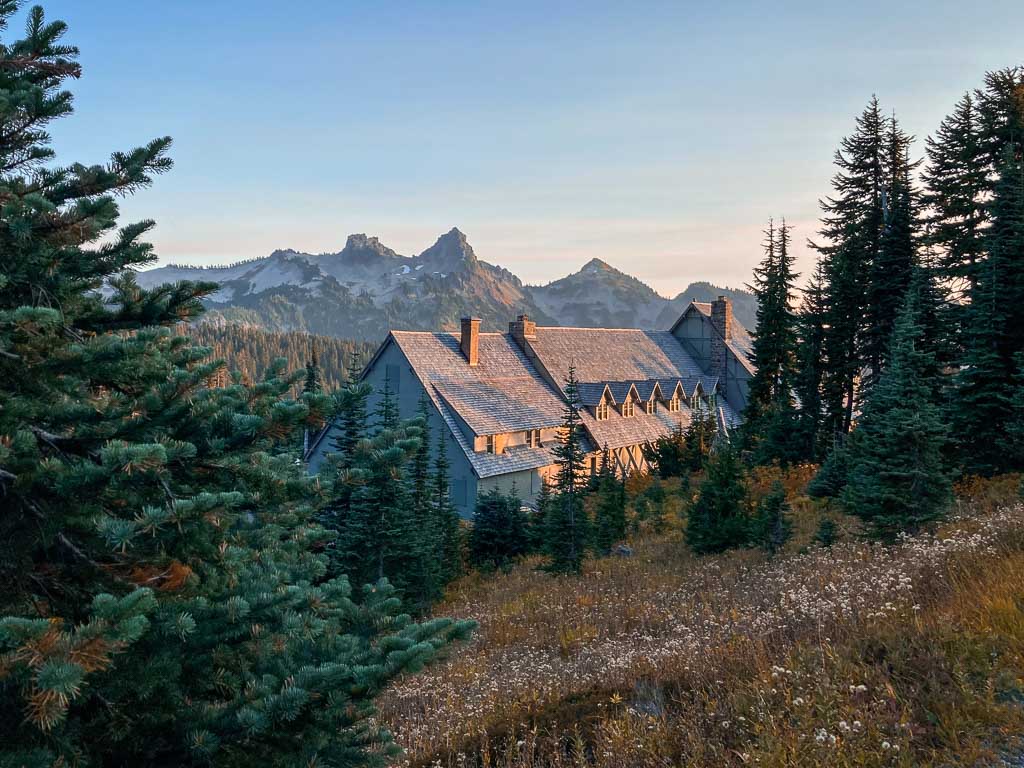
In order to get to the most beautiful fall locations in Mount Rainier National Park early in the morning, you’ll have to spend the night in the park (or in nearby towns like Packwood or Ashford).
Campgrounds at Ohanapecosh and Cougar Rock are open through early-October, but you can also stay at one of the grandest buildings and lodges in the national parks system.
The Paradise Inn, built in 1916 and designated as one of the “Great Lodges of the West”, still has its original rustic style and atmosphere. Located at popular Paradise, this amazing national park lodge also has a gift shop, post office, dining room and café.
It’s a phenomenal place to spend a night or two in Mount Rainier National Park, situated mere steps from the spectacular Skyline Trail and a short drive from Reflection Lakes.
You can check rates, availability and other information about the Paradise Inn here.
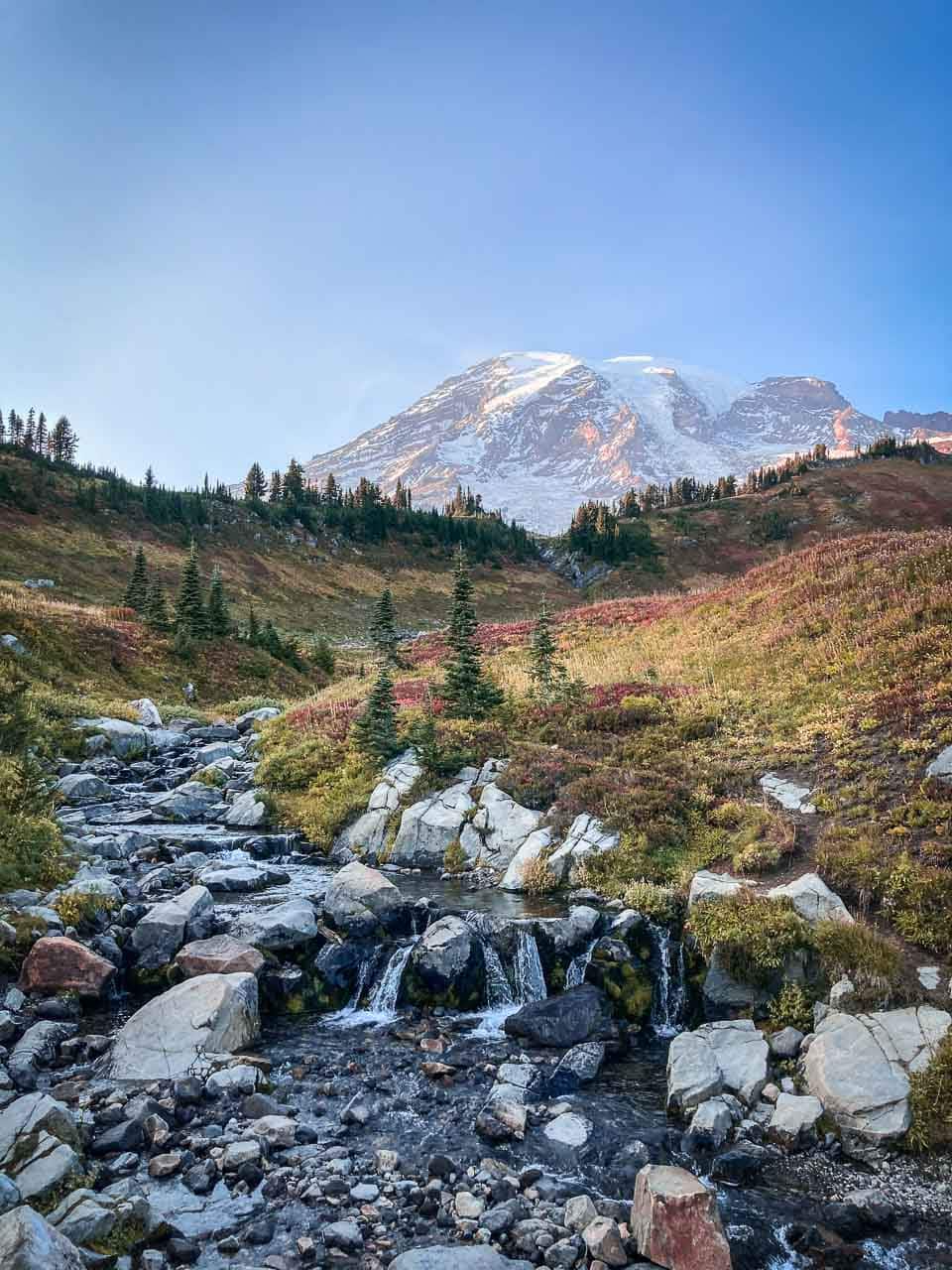
What Is the Best Time to See Fall Colors in Mount Rainier National Park?
Fall is arguably the best time of year to visit Mount Rainier National Park. Especially early-October is a gorgeous period to explore and hike in the park.
The ubiquitous huckleberries start turning red in late-September, usually peaking in early to mid-October.
Additionally, after the brief and sunny summer season, snow cover at high elevations is at its lowest. This allows you to hike to high-altitude places that are inaccessible during the rest of the year.
Combined with beautiful fall foliage in Mount Rainier, as well as active wildlife, these amazing hiking opportunities make visiting Mount Rainier National Park in the fall an unforgettable experience. Again, I recommend early-October for the best fall experience and most activity options.
However, if you’d like to see the extraordinary tamarack turn yellow, you’ll have to wait until November. After all other fall colors are gone, this deciduous larch species transforms into bright yellow.
Their presence is quite obvious in November, when their contrasting yellow colors make them stand out starkly from their evergreen neighbors.
- Early-October (huckleberries and other shrubs and small trees)
- November (tamarack (western larch))
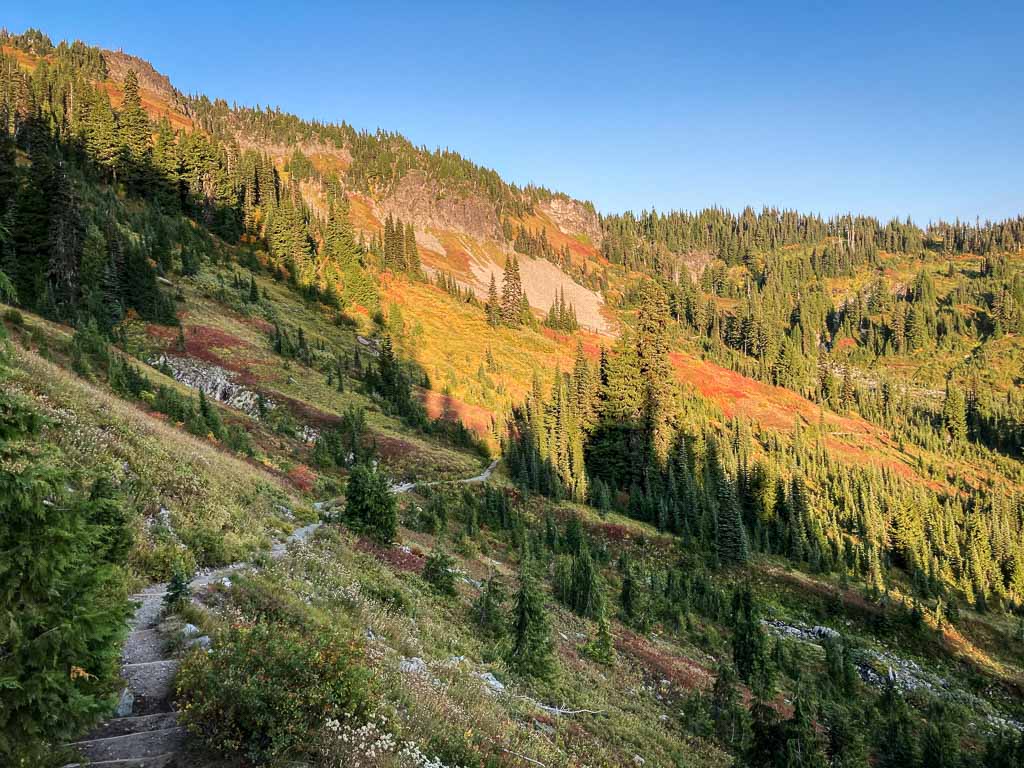
Where Is the Best Fall Foliage in Mount Rainier National Park?
Generally speaking, there are three main areas to focus on if you want to enjoy those vibrant Mount Rainier fall colors.
Because most trees in the park are evergreen conifers, such as spruce, pine, cedar and hemlock, you’ll want to go to higher elevations for the best fall foliage scenery at Mount Rainier. I did mention one recommended forest hike above, though (number four in the list).
Those areas are Paradise, Sunrise and the Tipsoo Lake-Chinook Pass area, all of which feature open subalpine forests and meadows.
It’s at these places that you’ll find those sprawling areas of huckleberries, which turn brilliant red in the fall.
Mount Rainier National Park’s vibrant huckleberries—not its trees—are the main reason this is one of the best national parks to visit for fall foliage.
- Paradise (huckleberries and other shrubs)
- Reflection Lakes (huckleberries and small trees)
- Sunrise (huckleberries and other shrubs)
- Tipsoo Lake & Chinook Pass (huckleberries, other shrubs and tamarack)
- Indian Henry’s Hunting Ground (huckleberries and other shrubs)
Have You Been to Mount Rainier National Park in the Fall? Share Your Mount Rainier Fall Adventures Below!
